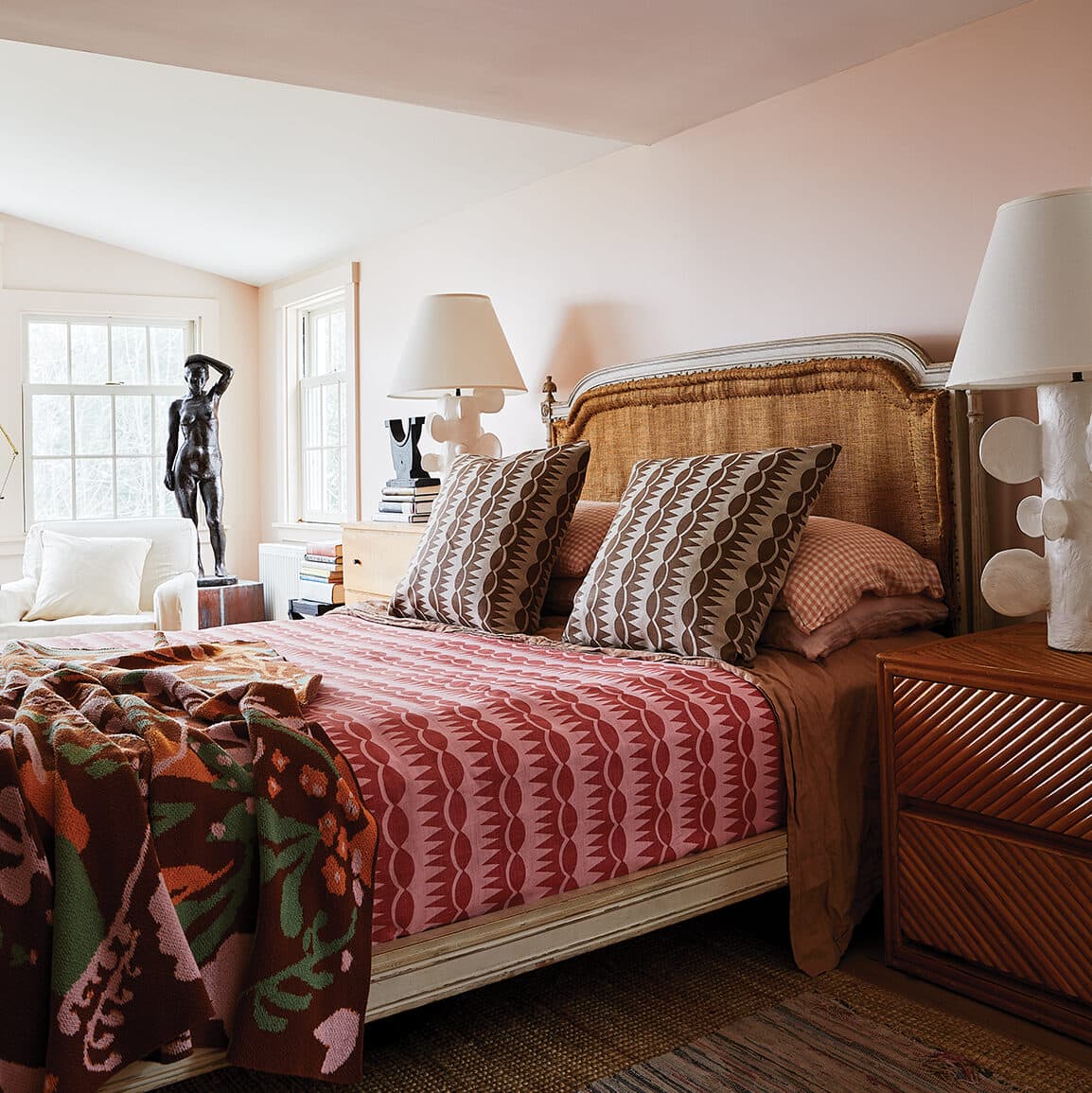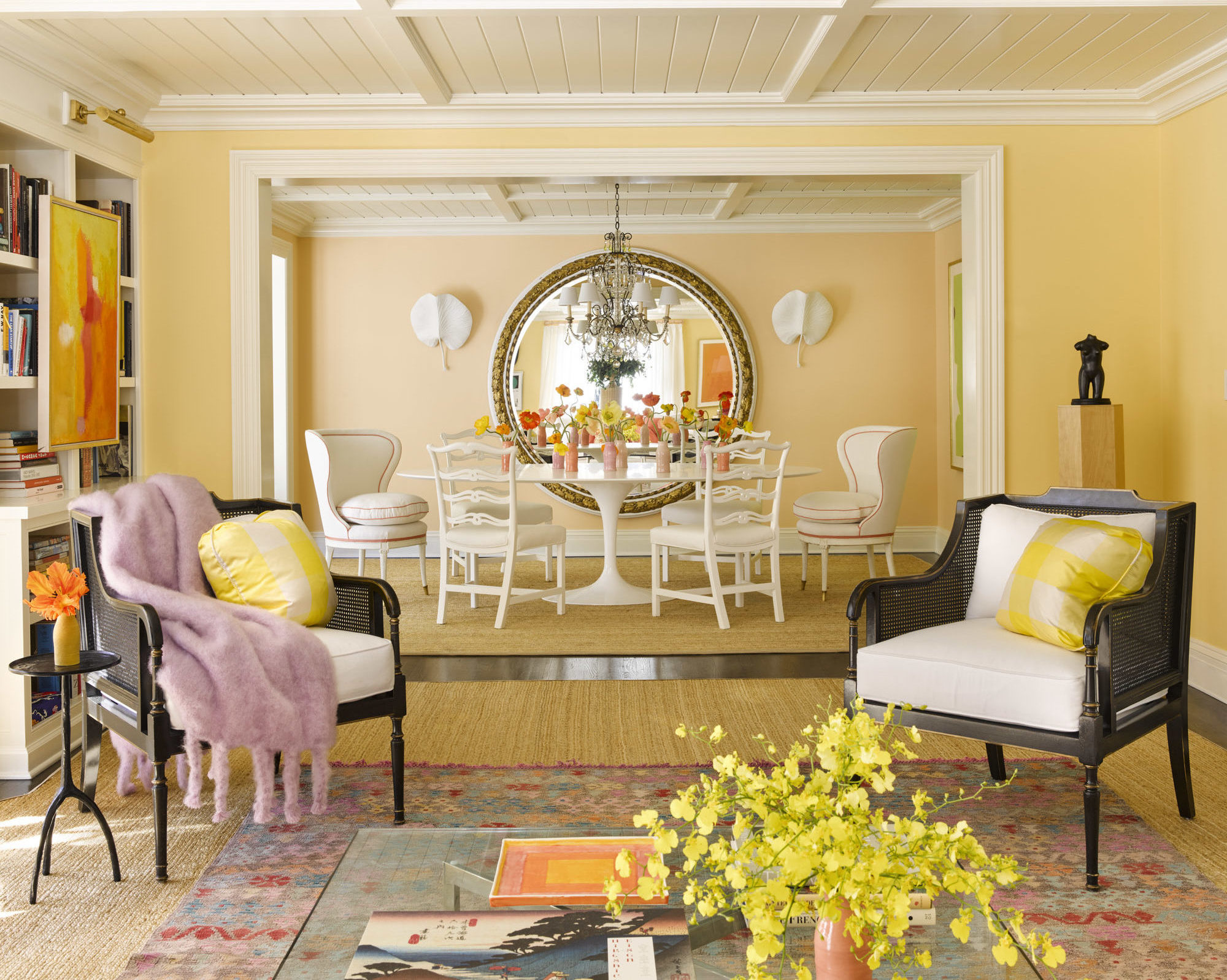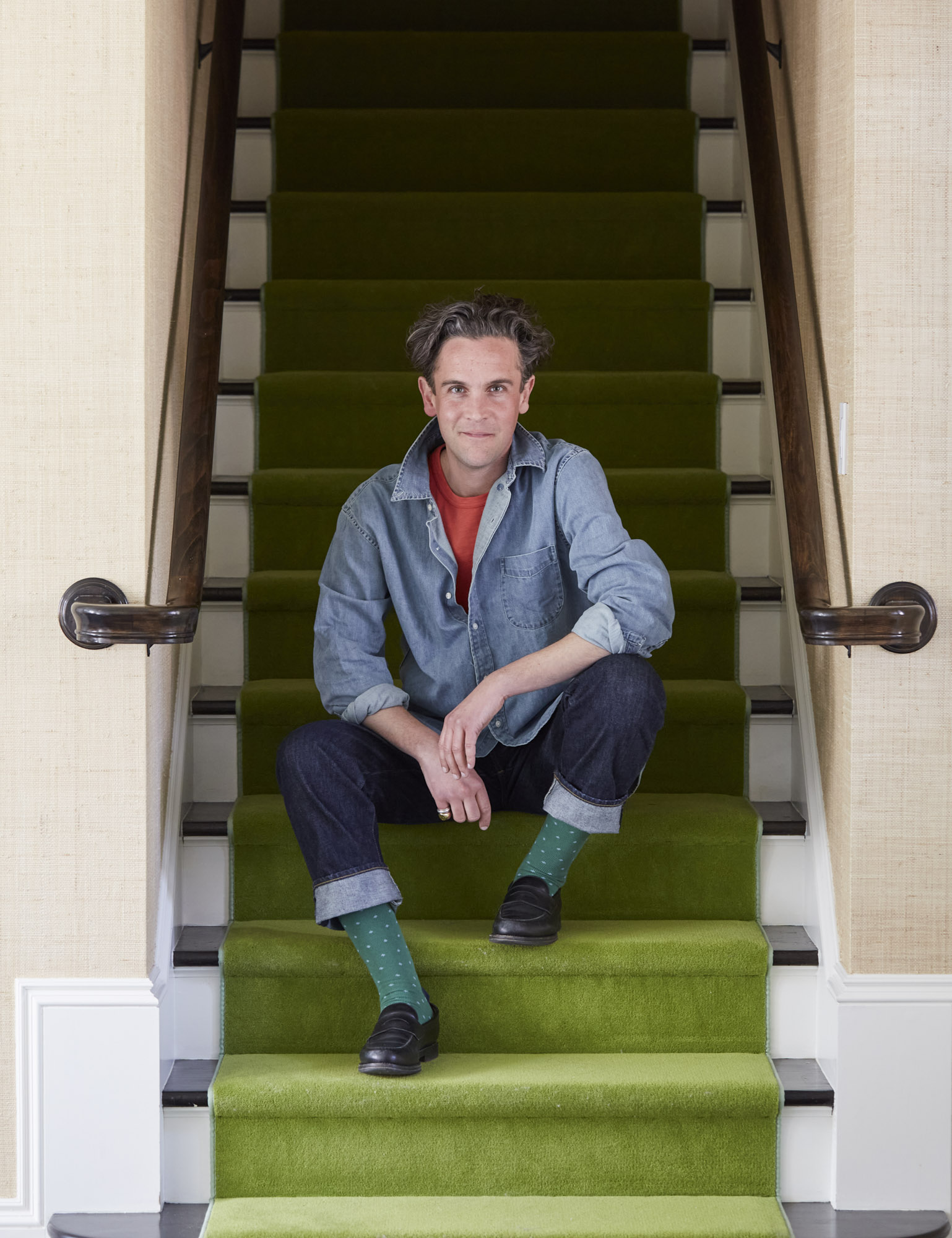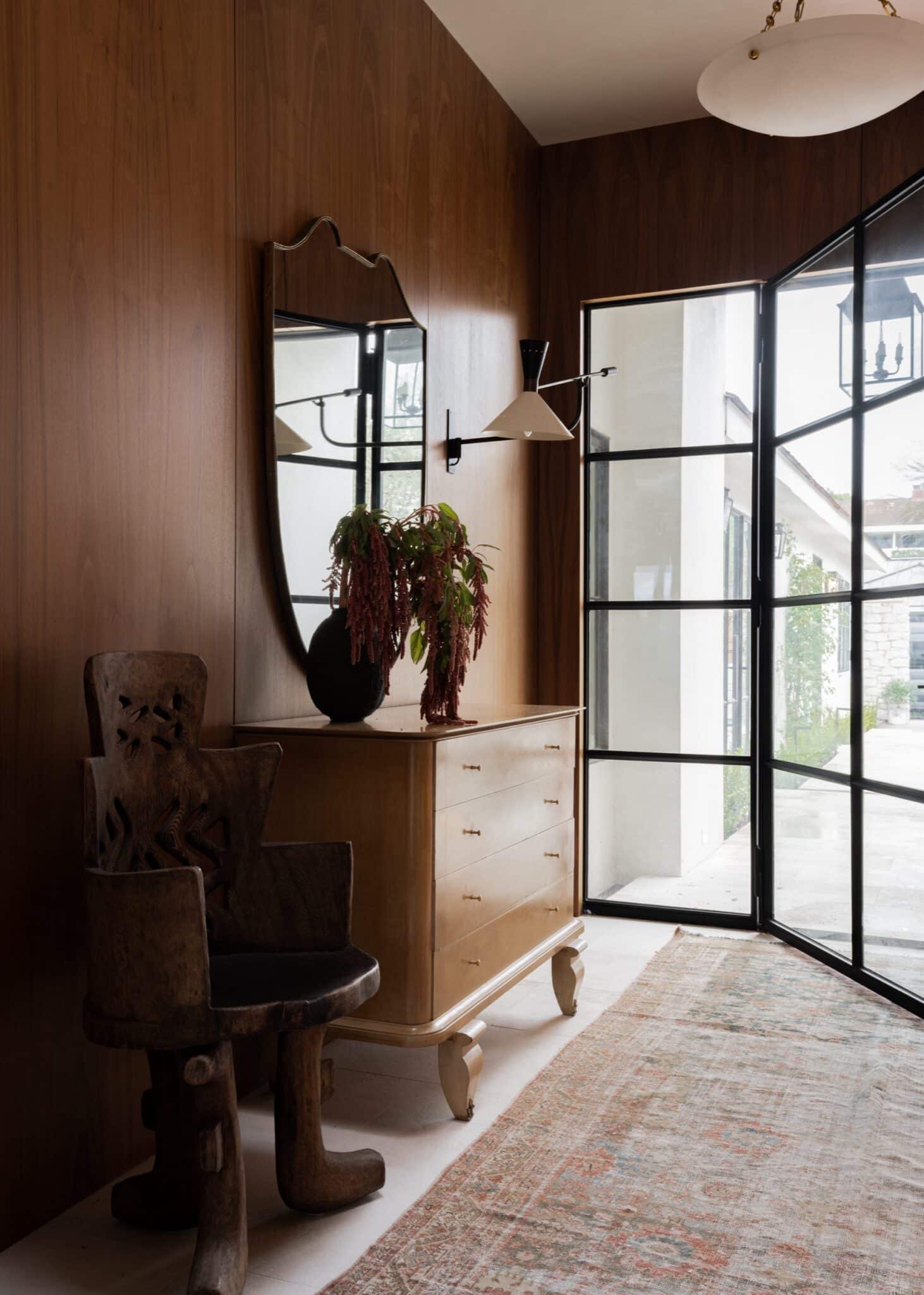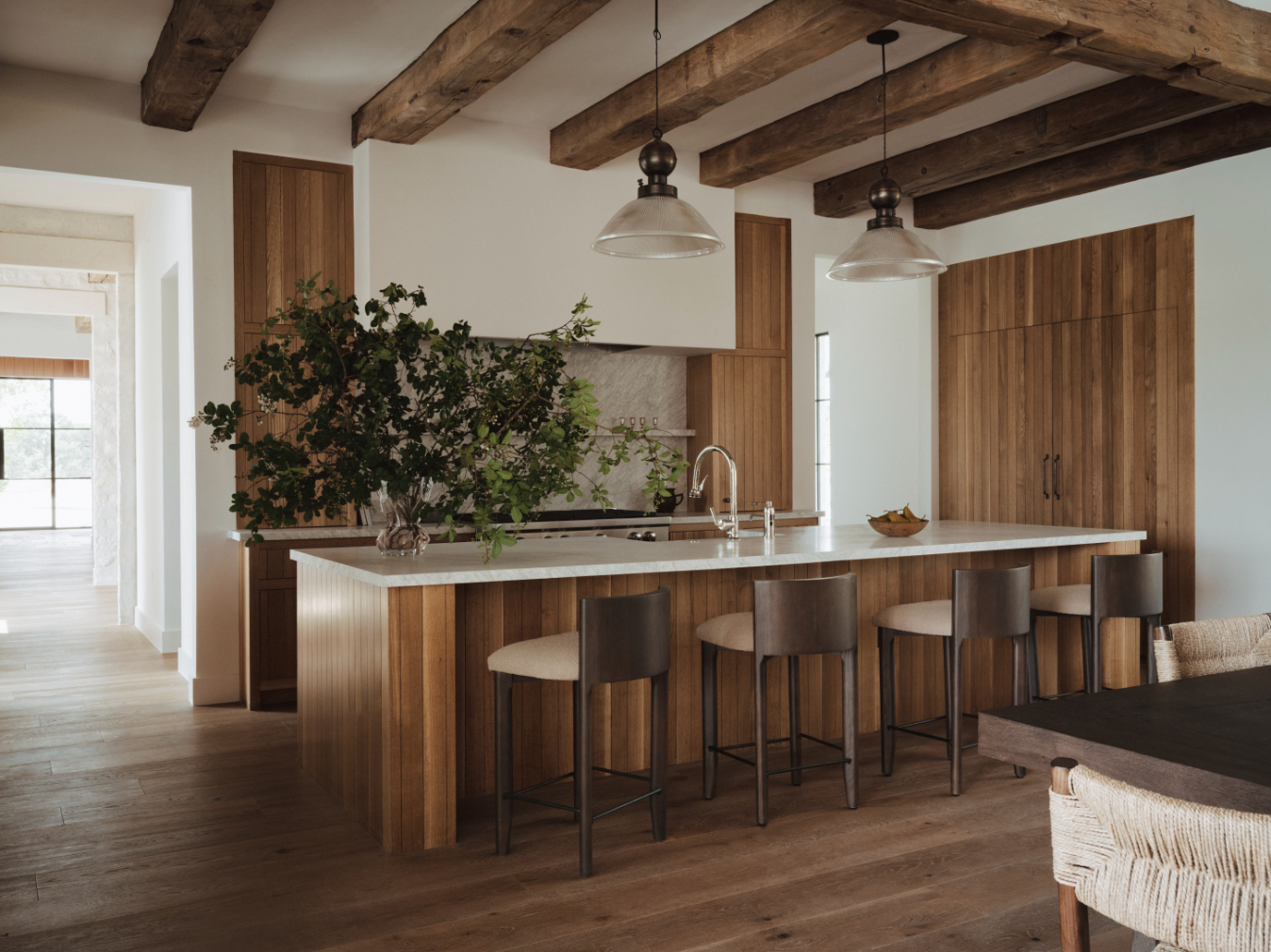Is it possible for a house—solid, four walls, a roof—to exist in two places at once? When you turn the design over to Patrick Mele, the answer is an exuberant, juicy, tropical-punch-flavored yes. The designer took a 1950s extended cape that’s a five-minute walk to the waters of the Long Island Sound in Greenwich, Connecticut, infused it with warm glowing colors, and deposited the interior on the sizzling sands of Ipanema beach.
The ultimate inspiration was Mele’s client, Heela Yang, who recently relocated from Brazil with her husband and son. “Heela is a glamorous woman in a glamorous business, but she’s razor-sharp smart, so the decoration couldn’t just be about pretty,” says Mele. And he’s right, of course. Yang, who got both her undergraduate degree and her MBA at Harvard, was an executive at a cosmetics company in New York City when she met her husband, who was based in Brazil, and a move to Rio followed soon after. Seduced by the distinctly Brazilian lifestyle, she first embraced it and then bottled it by starting her own line of beauty products, Sol de Janeiro (the brand’s Bum Bum Body Cream has achieved cult status). “We were working off a base of delicious Brazilian colors. It’s curves and sensual and smoldering and tan skin and beauty and happy,” says Mele. “The shades we ended up choosing are very makeup-y, in that they’re soft and feminine and light.”

A moss green runner heads up the stairs in the foyer, which is painted in a bold acid-yellow citrine that’s set off by a robin’s-egg-blue wing chair. “A lot of people would say ‘oh God, the colors clash,’ but when it’s done the right way and it’s a surprise, it’s the most exciting thing,” says Mele. He found the oversized milk glass lantern “which must have come out of an old church or a meeting house” in upstate New York, and refinished the metal with a faux verdigris, which makes the angles stand out against the star quilt.
Annie SchlechterYang is also a modernist at heart—“I could see her in a Richard Meier house or the de Menil house in Houston,” says Mele—so the walls were covered not with patterned paper, but with luscious coats of paint and mixed with lots of white trim to keep things clean and crisp. Yang kept an open mind, and was willing to consider adding some pre-Bauhaus pieces to her own collection of furniture to give the rooms a richness. In the breakfast room, her Saarinen table now cozies up to an early 19th-century painted armoire from legendary dealer Monique Shay. Another bold “this changes everything” move: the enormous round Regency mirror in the dining room, which “came out of an old hotel down south and just barely fit, but it was so worth squeezing in because it transforms the room,” says Mele. It also does the work of reflecting the light beeswax shade of the music room into the fresh pink straw of the dining room. “It’s like cutting open a gorgeous grapefruit with all those curves and the yellow and the pink together.”
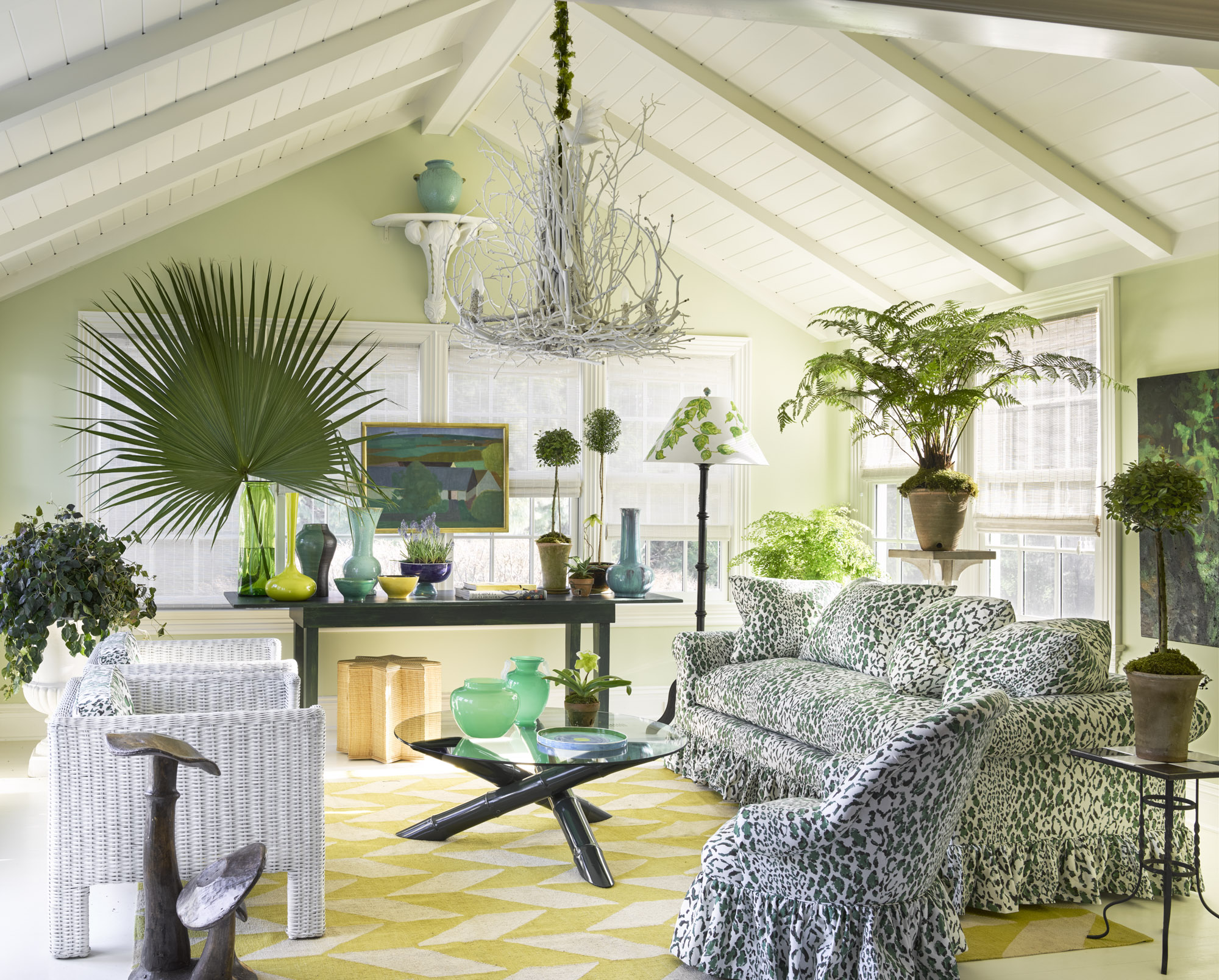
Pale wasabi on the walls and a painted white floor set the stage for laid-back but still sexy lounging in the sunroom. The furniture is upholstered in a classic Rose Cumming leopard chintz, and Mele refinished the bamboo coffee table in a glossy green and the twig chandelier in white to match the floors. An abstract Dutch landscape breaks up a long bank of windows beautifully while encapsulating all the greens in the room.
Annie Schlechter-
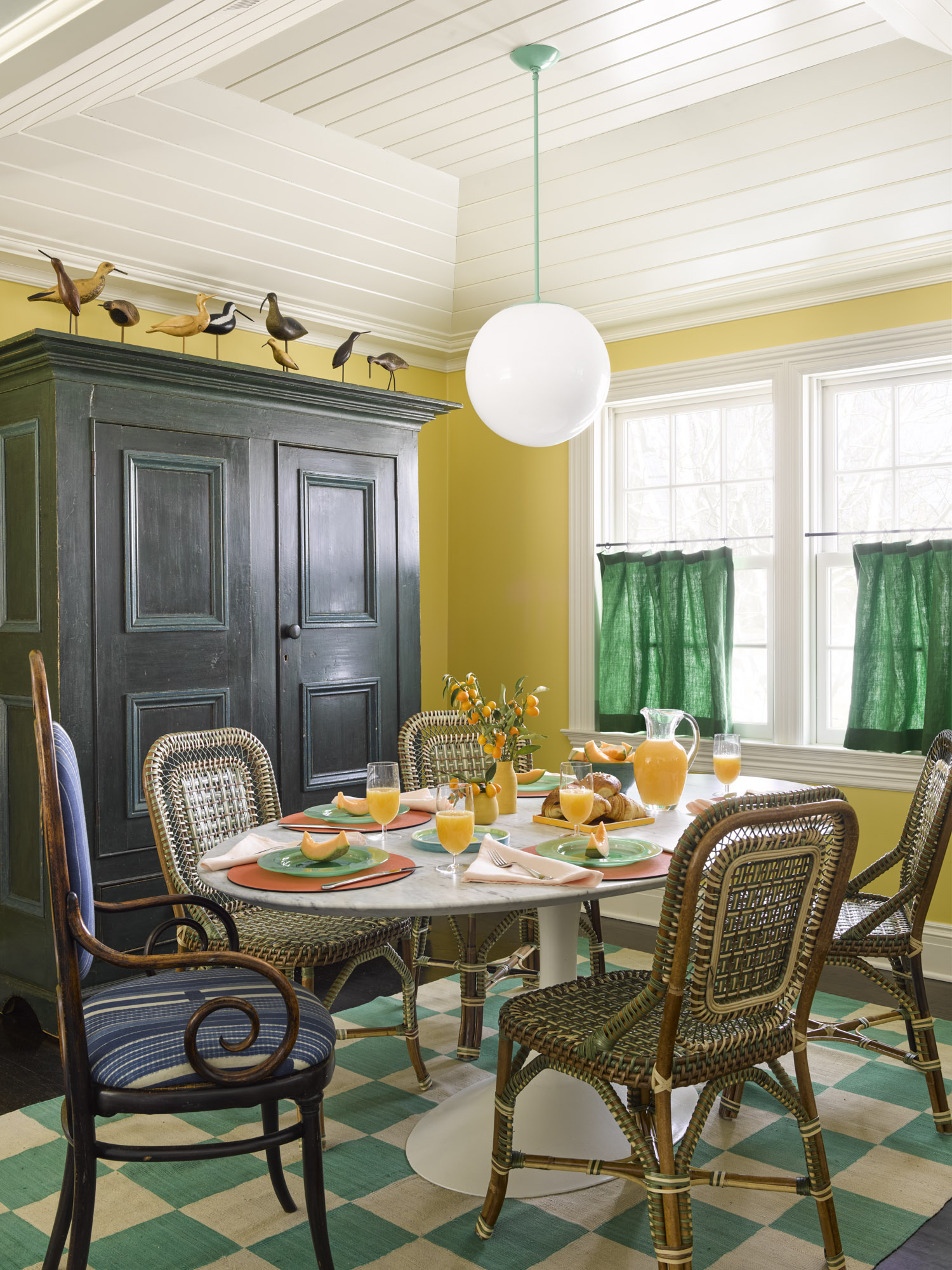
Pistachio-colored accents carry through the room, from the Swedish rug from Avery & Dash to the stem of the custom Avantgarden milk glass pendant, while Designers Guild linen café curtains deepen the green. The rattan chairs were made in Morocco for Creel and Gow, and the early 19th-century armoire from Monique Shay still carries its original waxy green paint job.
Annie Schlechter -
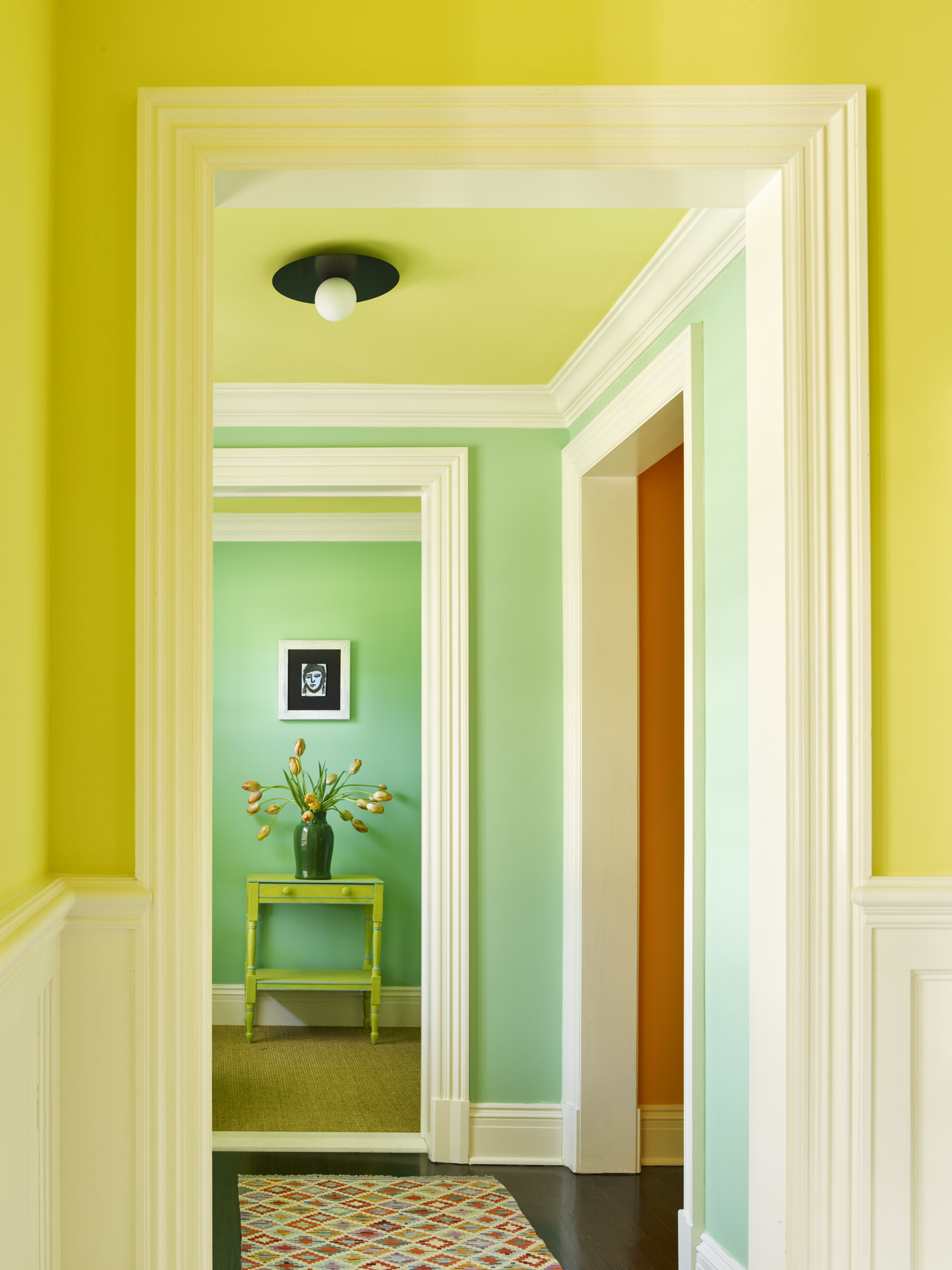
“I call it a pumped-up jade,” says Mele of the shade that sets the powder room aglow. The ceilings are done in the same acid yellow citrine that covers the foyer, while a Swedish rug from Avery & Dash picks up the entire palette. “It’s like sea glass all tumbled together,” says Mele.
Annie Schlechter
All those colors and curves are kept from going garish by paring way back on the embellishments. The spare fireplace is one example. Mele literally stripped it down, removing the original “builder’s Colonial” mantel, and then left it unadorned. He merely painted the stone surround white and extended the height with a plain mirror, which he punctuated with a piece of abstract art by Christopher Butler. Floors, too, are laid back and unfussy—most are either painted or simply covered in sisal, with a few Swedish rugs layered on top for touches of pattern. Window treatments are similarly deployed with thoughtful restraint. “We didn’t use a lot of anything on the windows, aside from the linen Schumacher sheers in the music room and the 1940s-style treatment in the bedroom, which is glam but tailored.”
While the house offers many things to love—including that five-minute walk to the water—Mele admits the space was not without its challenges, the squat rooms on the lower level foremost among them. To address that, Mele left those diaphanous sheers extra-long to exaggerate the height of the music room and give it more elegant proportions. And rather than change or add architecture, Mele employed some visual sleight of hand. The lone-star quilt in the foyer covers up the visual clutter of the banister, and the ho-hum hardwood in the foyer got all glammed up with nothing more than a checkerboard paint job that successfully gives the illusion of marble. Paint also magically lifts the ceiling in a few of the smaller rooms, where the yellow overhead surprises the eye.
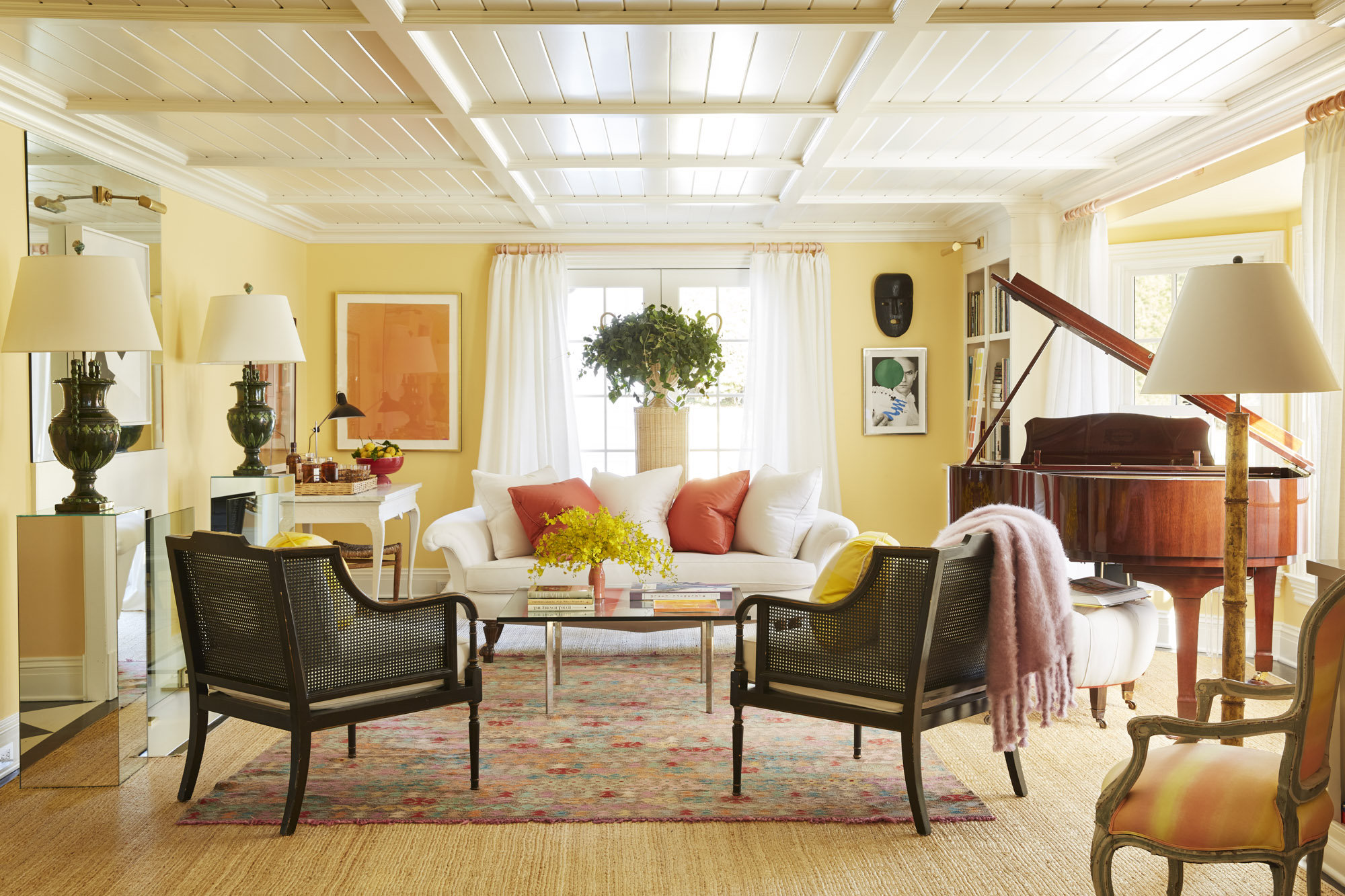
A pair of Regency cane chairs from Mele’s eponymous shop in Greenwich frames the view into the music room. The designer had custom “powder puff” hardware made for the flowy Schumacher linen sheers: “It’s an edible color that feels frothy and whipped and dessert-like, so everything feels soft and sun-kissed. And it matches the pink in the dining room so there’s a vibration to it,” he says. The shade is picked up in the grapefruit pink silk pillows, and the Swedish rug from Avery & Dash, which is layered over sisal.
Annie Schlechter-
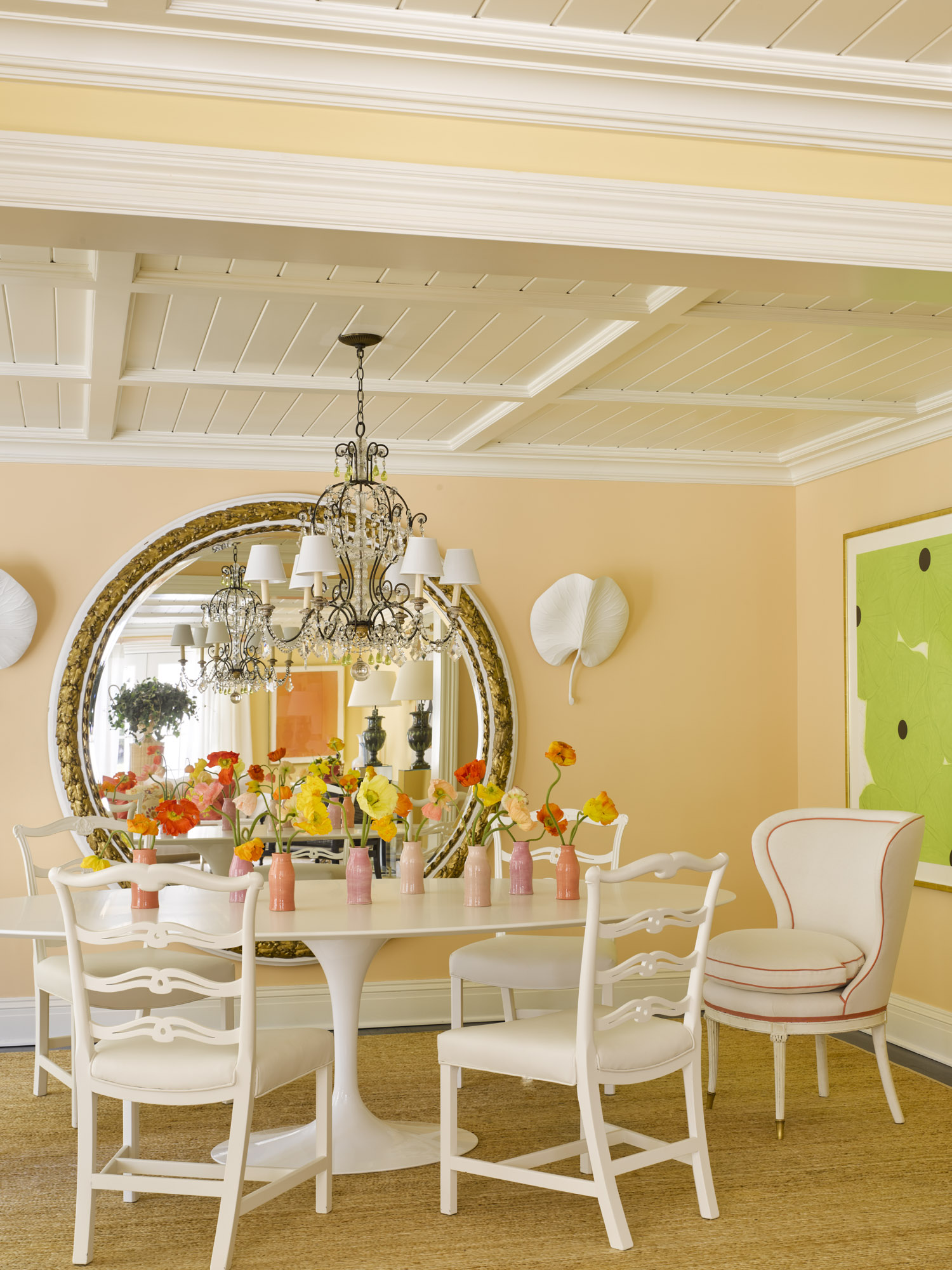
A kiwi green modernist canvas by Donald Sultan, which Mele sourced through Nick Savard at Avery & Dash in Stamford, Connecticut, dominates one end of the dining room. “That green on that pink wall is dynamite, and it relates to all the greens popping throughout the house,” says Mele. A set of Chippendale chairs refinished in white join a Saarinen table and a host-and-hostess chairs with “Elsa Peretti–level curves.”
Annie Schlechter -
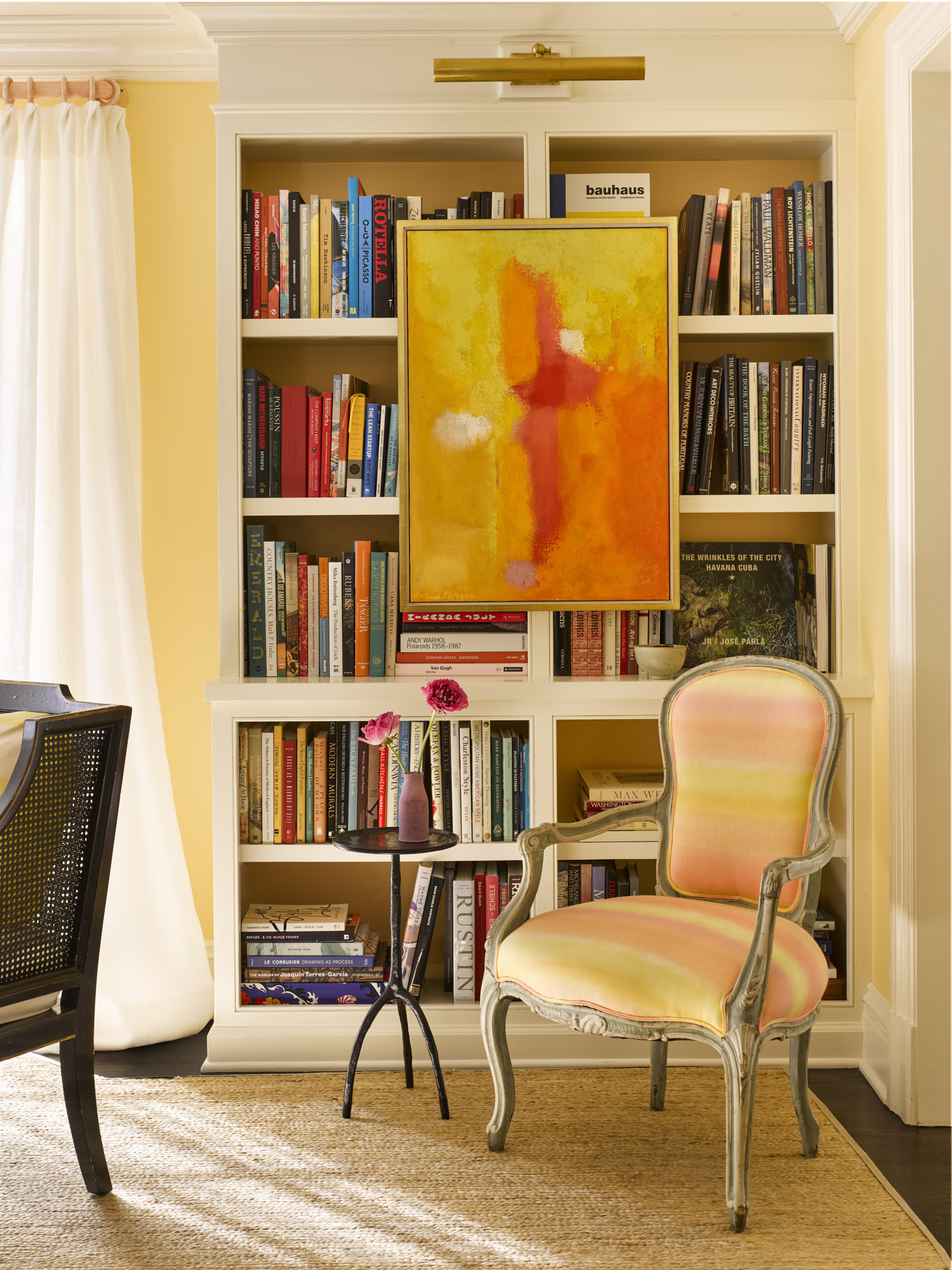
No pair of objects could better capture the mood of the home than this saturated color field painting from the 1960s and a classic Windsor chair the Mele re-covered with a bolt of sherbet-cake-colored cotton found years ago at an estate sale. “There’s a yin-and-yang color scheme, where the pinks and yellows work together like a grapefruit,” says Mele.
Annie Schlechter
When you really dig into the details of each room, it becomes clear that Mele relied on many other inspirations beyond the client herself. He mentions movies and shops and designers and muses that span decades and continents, all of them adding up to underline the deep catalog of visual references that Mele draws on and combines with his own personal vision to create vignettes that are rooted in history yet feel completely fresh. He mentions Tricia Guild and the juicy colors of her fabrics, and there in the breakfast room is a set of café curtains fashioned out of Designers Guild linen that look delectable indeed in a room painted in a shade that Mele describes as a “batter-y, buttery, egg-yolky yellow.” Then Mele mentions Anne Bancroft and a scene from The Graduate set in Mrs. Robinson’s garden-side bar. “It’s tropical and seductive and vixeny but also so chic,” and there in Yang’s sunroom is a vision that’s all of that, capped off with a spectacular Rose Cumming leopard-print chintz. And then he mentions Gert Voorjans and his design for Dries Van Noten’s two Left Bank shops in Paris, with the robin’s-egg-blue sofa and the citrine curtains with the black bullion fringe and it’s all right there in the foyer—the blue upholstered wing chair, the citrine walls, the notes of black—but done in a way that feels new and made just for this house.
This house, depending on how you look at it, is 4,800 miles away from Rio—or right in the colorful heart of it.
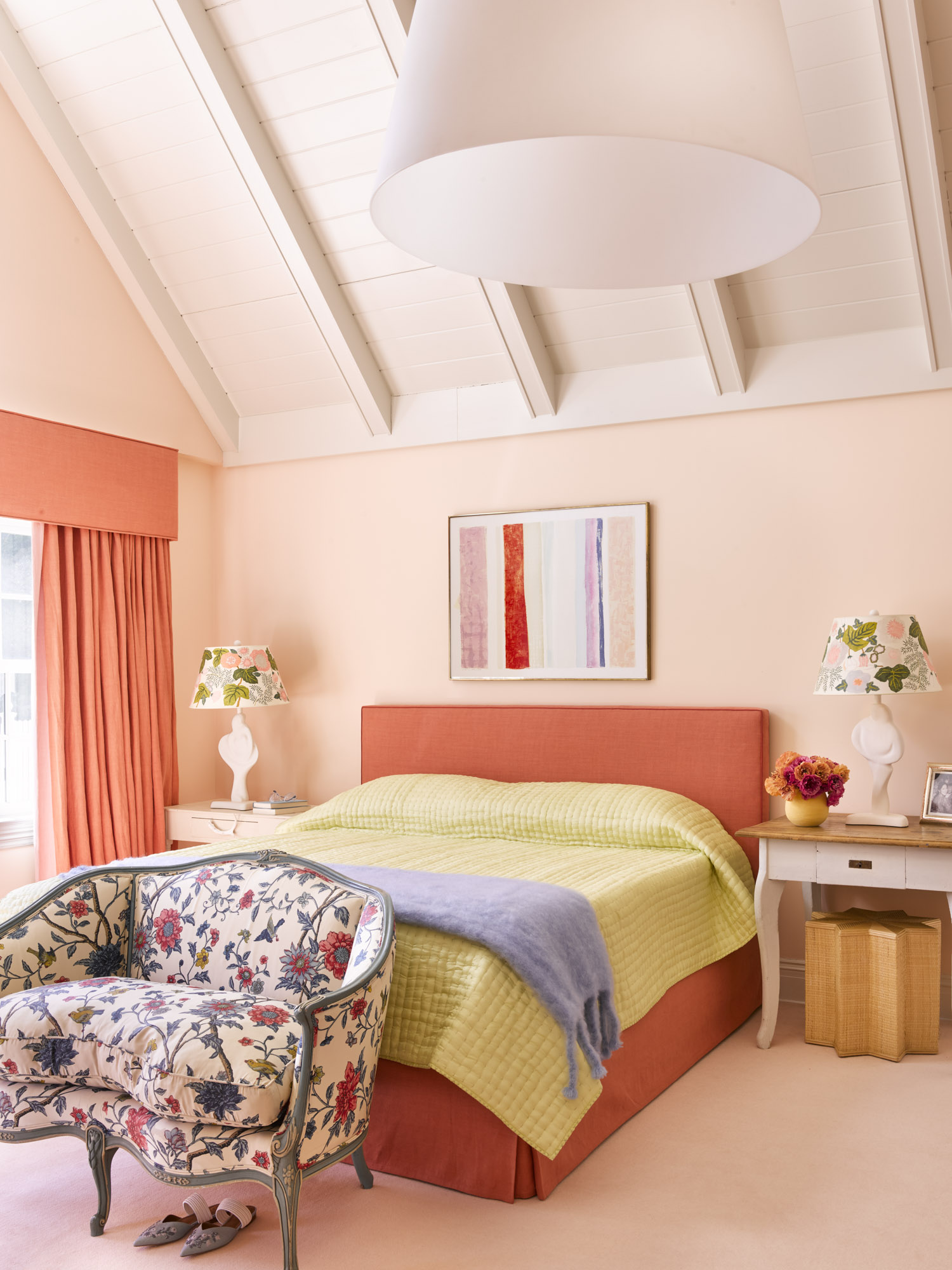
“I once read a study that said husbands love to be in feminine surroundings,” says Mele, explaining why Yang’s husband is the biggest fan of the bedroom. “It’s peachy and pink and Parisian glam and so ladylike.” The space originally felt like a too-big echo chamber, so Mele convinced Yang that covering the floor with a pale wall-to-wall carpet with a tight weave and a tight pile was the way to go. The windows got a 1940s-style formal window treatment with a cornice and panels that match the upholstered headboard and waterfall bedskirt. The bed is unfussily made with a bib lettuce-colored matelassé comforter from Designers Guild, and the settee is covered in a vintage silk floral.
Annie Schlechter



